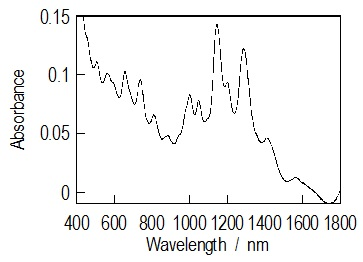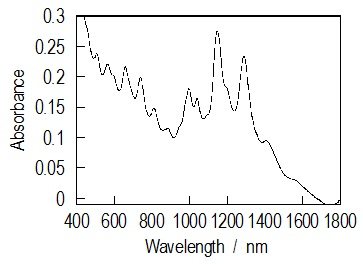Published TCIMAIL newest issue No.197 | New tool "TCI SpectraViewer" | [TCIPracticalExample] 2,2,2-Trifluoroethyl Etherification Using... | Product Document Searching Made Easy by 2D Code!
Maximum quantity allowed is 999
CAS RN: 1296211-78-3 | Product Number: E1127
4,4'-[1,2-Ethenediylbis(4,1-phenyleneiminocarbonyl)]bis(N-butyl-N,N-dimethylbenzenemethanaminium) Dichloride
![4,4'-[1,2-Ethenediylbis(4,1-phenyleneiminocarbonyl)]bis(N-butyl-N,N-dimethylbenzenemethanaminium) Dichloride No-Image](/medias/E1127.jpg?context=bWFzdGVyfHJvb3R8MzQ1MzJ8aW1hZ2UvanBlZ3xhRFl3TDJnMk1DODRPVEl4TmpJek5EazBOamcyTDBVeE1USTNMbXB3Wnd8ZGY1MjQ0ODE3YjM5MTg3MTRiNTVjYjUyZDM0OGY5ODUzMGFjMzYzNWQxNTE4Y2FmYmIxOTNhNDkyNTFhNmExOA)
Purity: >94.0%(T)
| Size | Unit Price | Hyderabad | Japan* | Quantity |
|---|---|---|---|---|
| 1G |
₹7,800.00
|
Contact Us | 36 |
|
*Upon orders receipt, Hyderabad stocks will be dispatched on the same day.
*Items available in Japan warehouse will be dispatched in 10-12 working days.
*INR price is exclusive of domestic taxes applicable.
*TCI frequently reviews storage conditions to optimize them. Please note that the latest information on the storage temperature for the products is described on our website.
| Product Number | E1127 |
| Purity / Analysis Method | >94.0%(T) |
| Molecular Formula / Molecular Weight | C__4__2H__5__4Cl__2N__4O__2 = 717.82 |
| Physical State (20 deg.C) | Solid |
| Storage Temperature | Room Temperature (Recommended in a cool and dark place, <15°C) |
| Condition to Avoid | Light Sensitive |
| CAS RN | 1296211-78-3 |
| Reaxys Registry Number | 22634941 |
| PubChem Substance ID | 354333621 |
| Appearance | White to Yellow to Green powder to crystal |
| Purity(Nonaqueous Titration) | min. 94.0 % |
| Pictogram |

|
| Signal Word | Warning |
| Hazard Statements | H315 : Causes skin irritation. H319 : Causes serious eye irritation. |
| Precautionary Statements | P264 : Wash skin thoroughly after handling. P280 : Wear protective gloves/ eye protection/ face protection. P302 + P352 : IF ON SKIN: Wash with plenty of water. P337 + P313 : If eye irritation persists: Get medical advice/ attention. P305 + P351 + P338 : IF IN EYES: Rinse cautiously with water for several minutes. Remove contact lenses, if present and easy to do. Continue rinsing. P362 + P364 : Take off contaminated clothing and wash it before reuse. P332 + P313 : If skin irritation occurs: Get medical advice/ attention. |
3.6 mg of E1127 was dissolved in 3 mL of pure water (18.8 MΩ·cm, TOC < 3 ppb) or D2O using a glass vial (ca. 0.12 wt%). The solution was then sonicated (80 W, 35 kHz) at room temperature. Heating by a dryer is also a useful method for solvation. 1.96 mg of SWCNTs was added into the solution of E1127. The E1127/SWCNT mixture was sonicated (80 W, 35 kHz, 1 h) at room temperature. The black-colored dispersion was then centrifuged to remove impurities such as amorphous carbons and metal particles (28500 x g, at 22 °C, 3 hrs). Upper 70 % of supernatant was corrected as a well-dispersed SWCNT dispersion.

10 mg of E1127 was dissolved in 20 mL of pure water (18.8 MΩ·cm, TOC < 3 ppb) or D2O using a glass vial (ca. 0.05 wt%). The solution was then sonicated (80 W, 35 kHz) at room temperature. Heating by a dryer is also a useful method for solvation. 7.0 mg of SWCNTs was added into the solution of E1127. The mixture was sonicated (80 W, 35 kHz, 1 h) at room temperature. Subsequently, the dispersion was subjected ultrasonication (60 W, 19 kHz, 4 hrs) at room temperature. The black-colored dispersion was then centrifuged to remove impurities such as amorphous carbons and metal particles (28500 x g, at 22 °C, 3 hrs). Upper 70 % of supernatant was corrected as a well-dispersed SWCNT dispersion.

A well-dispersed SWCNT dispersion was transferred to a dialysis tube (cutoff MW of 1000) to remove excess amount of E1127 from the dispersion. The tube filled with the dispersion of E1127/SWCNT system was put into a glass beaker with 3 L of pure water (18.8 MΩ·cm, TOC < 3 ppb) and was stirred overnight. The dialyzed dispersion was transferred into quartz cells and irradiated by an LED light source (365 nm, 100 mW/cm2) for several hours under magnetically stirring. After 3 hrs of light irradiation, precipitation of SWCNTs was completed for the dispersion treated with low power sonication. The SWCNT dispersion prepared using high power sonication took 7 hrs to recognize precipitation.
References
- Photoinduced Dispersibility Tuning of Carbon Nanotubes by a Water-Soluble Stilbene as a Dispersant
- Effective Nondestructive Purification of Single-Walled Carbon Nanotubes Based on High-Speed Centrifugation with a Photochemically Removable Dispersant
- Y. Matsuzawa, M. Yoshida, H. Ohyama, H. Kato, Patent JP5552641.
Articles/Brochures
Safety Data Sheet (SDS)
The requested SDS is not available.
Please Contact Us for more information.
Specifications
C of A & Other Certificates
Sample C of A
A sample C of A for this product is not available at this time.
Analytical Charts
The requested analytical chart is not available. Sorry for the inconvenience.



![4,4'-[1,2-Ethenediylbis(4,1-phenyleneiminocarbonyl)]bis(N-butyl-N,N-dimethylbenzenemethanaminium) Dichloride 4,4'-[1,2-Ethenediylbis(4,1-phenyleneiminocarbonyl)]bis(N-butyl-N,N-dimethylbenzenemethanaminium) Dichloride](/_ui/responsive/theme-tci/images/missing_product_zoom.jpg)

